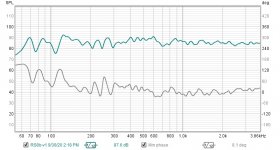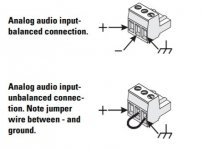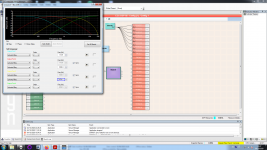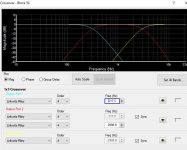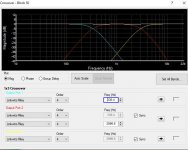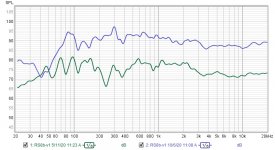I just measured the noise level of the fan, it is nearly 30dbA. The fan is a 10mm 24 volt EBM/Papst 414 rate for 18 dbA. I will be ordering a replacement and see if 12 dbA prop makes it quiet enough for me.
Wouldn't the heat generated be dependant on how hard it's working? Perhaps it doesn't need the fan for simple processing?
Once I start using it I will be able to answer that, it was just running doing nothing. The only thing making heat was the power supply. I pulled it out and is dusty, I figure a new one with maybe a series resistor to slow it down and it will be fine.
My Symetrix 8x8 DSP has a noisy 40mm (and pretty ineffective) fan. I modified the top cover so it was mostly perforated steel, fitted a 24V->12V converter (very cheap from eBay) and a silent 40mm fan and modified my equipment rack so it has two 80mm fans running at low RPM in push pull across the top. So now it still only uses up one rack space, runs cooler and is silent. Power consumption is 50W and is not strongly related to DSP load. The hottest spot is the PSU which is a 24V output only unit so would be quite easy to make external, however internally there are two layers of circuit boards so hot air tends to get trapped between them which is why I put so much effort into ensuring that there is airflow.
The QSC should be much easier to modify to silent or fanless operation as it doesn't have stacked circuit boards so assuming you don't need to have anything stacked on top of it you can make it 2u high and cut a hole in the top for a big fan extracting air.
The QSC should be much easier to modify to silent or fanless operation as it doesn't have stacked circuit boards so assuming you don't need to have anything stacked on top of it you can make it 2u high and cut a hole in the top for a big fan extracting air.
Some passive 6ch and 8ch volume pot's:
https://www.eltim.eu/en/attenuators-potentiometers/dact-attenuators/g-10000482
Must be some cheaper out there?
https://www.eltim.eu/en/attenuators-potentiometers/dact-attenuators/g-10000482
Must be some cheaper out there?
My Symetrix 8x8 DSP has a noisy 40mm (and pretty ineffective) fan. I modified the top cover so it was mostly perforated steel, fitted a 24V->12V converter (very cheap from eBay) and a silent 40mm fan and modified my equipment rack so it has two 80mm fans running at low RPM in push pull across the top. So now it still only uses up one rack space, runs cooler and is silent. Power consumption is 50W and is not strongly related to DSP load. The hottest spot is the PSU which is a 24V output only unit so would be quite easy to make external, however internally there are two layers of circuit boards so hot air tends to get trapped between them which is why I put so much effort into ensuring that there is airflow.
The QSC should be much easier to modify to silent or fanless operation as it doesn't have stacked circuit boards so assuming you don't need to have anything stacked on top of it you can make it 2u high and cut a hole in the top for a big fan extracting air.
I replaced the fan and put a 20 ohm 10W resistor in series with it and it now reads about 4db louder than the background noise in my office, I'm guess I won't hear it at all in my A/V console.
I have the QSC 922az up and working. Once I solved the output cable problem I'm liking what I se and hear. The problem I had was the DataPort Pinout was incorrect or just as likely my misunderstanding. I connected the V+ to the RCA signal and tied the shield from chassis ground and got no signal, then I connected to the V- and did get a signal. Unfortunately the signal was very weak and clipped before 75 dbA. When I measured the distortion was over the top. Finally I used an oscilloscope to see what was happening, a real bad signal is what I found. So I set the scope to add channel one and two to get a balanced reading between V+ and V-. All of the sudden I had a good signal, when I looked at both channels it turns out what I thought was V- had a beautiful signal and V+ had nothing. So now I rebuilt my cables with the shield to chassis ground and signal to the RCA connected to V-. Bingo, I'm hooked up to a 3 way with a mix of drivers I have had laying around for years and it sounds very good. Here is a sweep after fiddling around for 15 minutes in the QSC Venue Manager. Next I going to try a Harsch crossover.
Attachments
So pc-based crossovers aren´t that bad.
i have zero experience with these, maybe i have to try them some day
i have zero experience with these, maybe i have to try them some day
I have the QSC 922az up and working. Once I solved the output cable problem I'm liking what I se and hear. The problem I had was the DataPort Pinout was incorrect or just as likely my misunderstanding. I connected the V+ to the RCA signal and tied the shield from chassis ground and got no signal, then I connected to the V- and did get a signal. Unfortunately the signal was very weak and clipped before 75 dbA. When I measured the distortion was over the top. Finally I used an oscilloscope to see what was happening, a real bad signal is what I found. So I set the scope to add channel one and two to get a balanced reading between V+ and V-. All of the sudden I had a good signal, when I looked at both channels it turns out what I thought was V- had a beautiful signal and V+ had nothing. So now I rebuilt my cables with the shield to chassis ground and signal to the RCA connected to V-. Bingo, I'm hooked up to a 3 way with a mix of drivers I have had laying around for years and it sounds very good. Here is a sweep after fiddling around for 15 minutes in the QSC Venue Manager. Next I going to try a Harsch crossover.
Hi mtidge,
I use Dataport amps and I/O frames under the q-sys ecosystem, a bunch.
All DE-15 dataport pinouts are the same for all products.
Link for pinouts which i guess you have..DataPort Pinout
So if L =ch1 and R =ch2: single channel L+ is pin7 , & R+ is pin 8.
Combining the standard QSC way of connecting unbalanced outputs per snip below:
L- = pin 1 jumped with pin 6 (ground)
R- = pin 11 jumped with pin 6 (ground)
Is this where you've landed? Hope so !
And hope this helped !
It's a bit of a shame the 922az doesn't have euroblock outputs in addition to the DB-15, but that's no real biggie...
Cause for a non FIR DSP solution, it looks dirt cheap awesome to me.
Good tip by kipman imo 🙂
Attachments
One important point if hacking cables together is that VGA cables while having the right DB-15-HD connector often connect pins together at the connector as these are common grounds so potentially short the QSC dataport. In the case of the dataport amps this can result in the amp failing. I have a QSC BASIS 922DZ (digital input version) that I'm making cables for at the moment.
There are lots of older pro audio DSPs that get removed from conference venues etc. that have good specs. Its worth checking before buying them though that you can get the configuration software as some companies only distribute the software via dealers. I have used the QSC and Symetrix DSPs and also see Peavy media matrix and Biamp hardware going cheaply.
There are lots of older pro audio DSPs that get removed from conference venues etc. that have good specs. Its worth checking before buying them though that you can get the configuration software as some companies only distribute the software via dealers. I have used the QSC and Symetrix DSPs and also see Peavy media matrix and Biamp hardware going cheaply.
Hi mtidge,
I use Dataport amps and I/O frames under the q-sys ecosystem, a bunch.
All DE-15 dataport pinouts are the same for all products.
Link for pinouts which i guess you have..DataPort Pinout
So if L =ch1 and R =ch2: single channel L+ is pin7 , & R+ is pin 8.
Combining the standard QSC way of connecting unbalanced outputs per snip below:
L- = pin 1 jumped with pin 6 (ground)
R- = pin 11 jumped with pin 6 (ground)
Is this where you've landed? Hope so !
And hope this helped !
It's a bit of a shame the 922az doesn't have euroblock outputs in addition to the DB-15, but that's no real biggie...
Cause for a non FIR DSP solution, it looks dirt cheap awesome to me.
Good tip by kipman imo 🙂
Maybe there something wrong with my unit, but I can only get output by using pin 6 for the shield and pin 1 for channel 1 signal and pin 11 for channel 2 signal. There is no signal on pins 7 and 8. I will check all pins for signal eventually.
One important point if hacking cables together is that VGA cables while having the right DB-15-HD connector often connect pins together at the connector as these are common grounds so potentially short the QSC dataport. In the case of the dataport amps this can result in the amp failing. I have a QSC BASIS 922DZ (digital input version) that I'm making cables for at the moment.
There are lots of older pro audio DSPs that get removed from conference venues etc. that have good specs. Its worth checking before buying them though that you can get the configuration software as some companies only distribute the software via dealers. I have used the QSC and Symetrix DSPs and also see Peavy media matrix and Biamp hardware going cheaply.
Thanks for the tip, my test setup sounds clean to me. Once I work with it for a while I will post a detailed evaluation. I'm no working on a remote trigger circuit with a shutoff delay. I can live with a 35 second wait on the first power up of the day, but I use a Harmony remote to switch my system and it powers the receiver off and on when switching between music and video, no way I want to power the dsp on and off each time, I figure a 5 minute power off delay will be perfect. Now I just need to get all the parts to fit inside the box.
One important point if hacking cables together is that VGA cables while having the right DB-15-HD connector often connect pins together at the connector as these are common grounds so potentially short the QSC dataport.
Good point, (crucial point for dataport amps)...one i had forgotten.
QSC's Parts Store sells DB-15's without any internal pins connecting, in various lengths pretty inexpensively
(which isn't always the case with their parts prices 🙁 )
miniReview of teh QSC Basis 922az
This is my initial judgment of the QSC Basis 922az, I might change my mind. I like it, especially at the price I paid, roughly $127.00 USD on ebay. It has an easy to use interface and doesn't seem to inject much noise into the signal. Technically the inputs and outputs are very versatile, the inputs support 1.5Vms, 3 Vms, 9Vms and 18Vms fixed at 24 bit. The outputs are QSC DataPorts, which look VGA ports that contain 2 balanced channels, I simple bought some DB15HD connectors and chopped up some Amazon Basics RCA patch cables to use them. My unit might be defective because I only get signal on the inverted output pin, not an issue for me because my amplifier is un-balanced. It is also possible that this a balanced output, but not differential, but the single output will go to 20V p-p before clipping. The biggest surprise for me is the lack of precision of the filters, I'm used to picking any frequency for a filter or PEQ. This unit has a limited fixed frequency points for everything. This includes signal generators, crossovers, Graphic EQ and filters. There are plenty of frequency points, so this might actually mater in real world use. It does have a 40MM fan, it is a little noisy, but it might be fine removing it. I can't hear over the music. Lastly it has two ethernet ports one is QSC control, which allows both design configuration and live monitoring. The second interface is CobraNet which does every thing QSC control does plus allows sending signals to other CobraNet devices, I just wish I could find a software driver or player to send music to it. Both of these have a poorly designed TCP/IP design, the subnet mask is fixed at 255.255.255.0 so if you have something bigger than class C you will have problems. I put together a spreadsheet to compare it to a miniDSP 2x4. Ultimately it is more versatile than the mimiDSP and less versatile than a device controlled by Sigma Studio. Even though it doesn't allow filters below 20hz, it does pass signals down to 1hz. This will prevent me from using to EQ a sub woofer because of the need for sub sonic filters.
This is my initial judgment of the QSC Basis 922az, I might change my mind. I like it, especially at the price I paid, roughly $127.00 USD on ebay. It has an easy to use interface and doesn't seem to inject much noise into the signal. Technically the inputs and outputs are very versatile, the inputs support 1.5Vms, 3 Vms, 9Vms and 18Vms fixed at 24 bit. The outputs are QSC DataPorts, which look VGA ports that contain 2 balanced channels, I simple bought some DB15HD connectors and chopped up some Amazon Basics RCA patch cables to use them. My unit might be defective because I only get signal on the inverted output pin, not an issue for me because my amplifier is un-balanced. It is also possible that this a balanced output, but not differential, but the single output will go to 20V p-p before clipping. The biggest surprise for me is the lack of precision of the filters, I'm used to picking any frequency for a filter or PEQ. This unit has a limited fixed frequency points for everything. This includes signal generators, crossovers, Graphic EQ and filters. There are plenty of frequency points, so this might actually mater in real world use. It does have a 40MM fan, it is a little noisy, but it might be fine removing it. I can't hear over the music. Lastly it has two ethernet ports one is QSC control, which allows both design configuration and live monitoring. The second interface is CobraNet which does every thing QSC control does plus allows sending signals to other CobraNet devices, I just wish I could find a software driver or player to send music to it. Both of these have a poorly designed TCP/IP design, the subnet mask is fixed at 255.255.255.0 so if you have something bigger than class C you will have problems. I put together a spreadsheet to compare it to a miniDSP 2x4. Ultimately it is more versatile than the mimiDSP and less versatile than a device controlled by Sigma Studio. Even though it doesn't allow filters below 20hz, it does pass signals down to 1hz. This will prevent me from using to EQ a sub woofer because of the need for sub sonic filters.
Attachments
So pc-based crossovers aren´t that bad.
i have zero experience with these, maybe i have to try them some day
Here?:
CamillaDSP - Cross-platform IIR and FIR engine for crossovers, room correction etc.
//
Hmm I haven't had chance to investigate your dataport issue because my 922dz is misbehaving after I partially disassembled it to poke about with my oscilloscope (sigh). Just using the - outputs is perfectly fine in an unbalanced system, it seems very odd though if it was a fault that it effects all channels.
As for the fixed frequency thing, I don't think that's the case I can set any frequency/Q I want (attached screenshot).
You should be able to set IP address/subnet mask via the front panel or over telnet it requires different IP ranges for the cobranet (Cnet) ip address and control interface.
Another random bit of QSC info is that on the 922dz it will accept a normal unbalanced SPDIF signal to the AES/EBU ports from my DOUK xmos based usb SPDIF sender and also from a PC motherboard header (TTL logic signal) so its not checking the format bits. Its receiver has input transformers so as long as your signal is big enough it will work.
A solution to wanting digital inputs is you could get a 922dz and connect it to the 922az via cobranet.
Your right about sub 20Hz filters generally been absent from pro gear, I run reflex subs tuned to 27Hz so have protective high pass at 25Hz so its never been much of an issue for me but its a good point.
As for the fixed frequency thing, I don't think that's the case I can set any frequency/Q I want (attached screenshot).
You should be able to set IP address/subnet mask via the front panel or over telnet it requires different IP ranges for the cobranet (Cnet) ip address and control interface.
Another random bit of QSC info is that on the 922dz it will accept a normal unbalanced SPDIF signal to the AES/EBU ports from my DOUK xmos based usb SPDIF sender and also from a PC motherboard header (TTL logic signal) so its not checking the format bits. Its receiver has input transformers so as long as your signal is big enough it will work.
A solution to wanting digital inputs is you could get a 922dz and connect it to the 922az via cobranet.
Your right about sub 20Hz filters generally been absent from pro gear, I run reflex subs tuned to 27Hz so have protective high pass at 25Hz so its never been much of an issue for me but its a good point.
Attachments
I have bypassed the passive XO in my 3 way book shelf and simply put a 20ufd cap to protect the tweeter. It took a few hours to re-work it, had to switch from a terminal cup with 5 way binding posts to two SpeakOns. I worked on the the configuration of the QSC and discovered that switching the inputs to 3v and dropping the outputs to -9 db cleaned up the sound a lot and made the master volume on the AVR more reasonable. I tried measuring the driver offsets by using LW2 crossovers and adjusting the delay to get the biggest null, what confused me is I get the null with the mid reversed. My experience has been that a 2nd order XO should make the null with the drivers in phase, am I wrong? I did a little level matching and EQ and here are the results. Green is with a passive XO measured outside on top of a 6 foot ladder, blue is the QSC connected to a Speaker Craft BB865 on a stand in my clutter 10' x 12' office.
Attachments
- Home
- Loudspeakers
- Multi-Way
- Going Active What DSP should I use?
